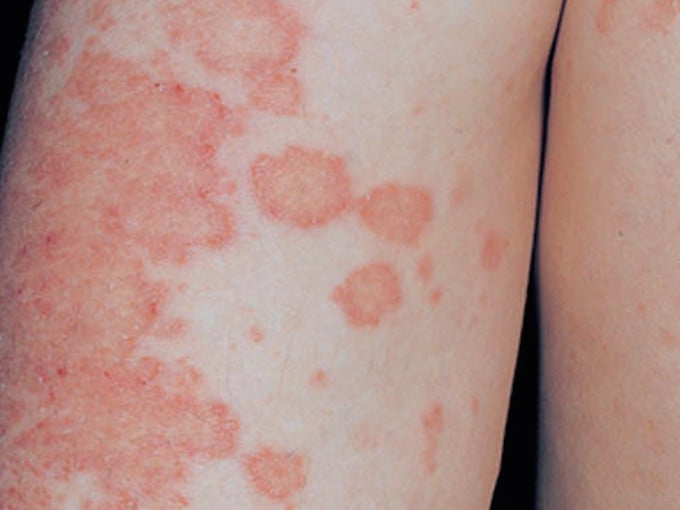In the human body, biofilm colonies are the main reason that certain conditions take so long to get handled. In my opinion, if it were not for “biofilm”, conditions caused by the microorganisms – Candida albicans, Candida spp, H. pylori, Lyme bacteria (Borrelia burgdorferi) and many others, would be far easier to diagnose and/or treat. It is crucial in any treatment protocol to first handle the biofilm. By doing so, it will make a significant difference in the amount of time, money, and effort spent on treating many, so-called, stubborn conditions – like eczema.
There are an estimated 30-35,000,000 million Americans affected by eczema: 1-3% of adults and 10-20% of all children. Eczema is a general term used to describe a group of skin conditions caused by inflammation, such as atopic dermatitis or heat rash. The cause or trigger for those with the predisposition to develop eczema can be obvious or obscure. The obvious cause/trigger can be the inflammation/immune reaction created from drinking cow’s milk or eating wheat/gluten, as well as many others (soy, egg, nuts…). A more obscure cause can be when one develops biofilm from staphylococcal bacteria, which are normally found on the skin.
Herbert B. Allen, and his team, at Drexel University College of Medicine, discovered that swabs taken from those with eczema and analyzed had staphylococcal biofilm. Dr. Allen reports that “The biofilm blocks sweat ducts, which activates molecules in the immune system known to create itching and inflammation.”
11-22-23 Update: New Clues Into the Head-Scratching Mystery of Itch – Researchers identify common microbe as the previously unknown culprit behind the itch
Highlights:
- The bacterium Staph. aureus is found on almost every patient with the chronic condition atopic dermatitis. The itch can be caused by the microbe itself.
- The study experiments showed that S. aureus releases a chemical (protease V8) that activates a protein (PAR1) on the nerve fibers that transmit signals from the skin to the brain.
- The bacterial enzyme protease V8 was single-handedly responsible for initiating itch in mice. Human skin samples from patients with atopic dermatitis also had more S. aureus and higher V8 levels than healthy skin samples.
- V8 triggers itch by activating a protein called PAR1, which is found on skin neurons that originate in the spinal cord and carry various signals —touch, heat, pain, itch — from the skin to the brain. Normally, PAR1 lies dormant but upon contact with certain enzymes, including V8, it gets activated.
- Interestingly, various immune cells implicated in skin allergies and classically known to cause itch — mast cells and basophils — did not drive itch after bacterial exposure, the experiments showed. Nor did inflammatory chemicals called interleukins, or white cells, which are activated during allergic reactions and are also known to be elevated in skin diseases and even in certain neurologic disorders.
- Because PAR1 — the protein activated by S. aureus — is involved in blood clotting, researchers wanted to see whether an already approved anticlotting drug that blocks PAR1 would stop itch. It did.
- The itchy mice whose skin was exposed to S. aureus experienced rapid improvement when treated with the drug.
Dr. Ettinger’s Protocol for Topical Biofilm Disruption.
This protocol has worked on some of my patients, but not others. I only recommend it for stubborn areas that do not respond to a systemic protocol (dietary & lifestyle changes combined with supplements that aid in biofilm disruption, like NAC, serrapeptase, lactoferrin, and others, as well as those that block mTOR, COX, and LOX inflammatory pathways, as well as adding those that stimulate the AMPK, and NO pathways. I recommend these, but there will be trial and error as this is recommended here w/o my ability to make a personalized recommendation. mTOR Inhibitors: EGCG, turmeric extract, ginger, boswellia, quercetin, bromelain, and others. AMPK stimulator gynostemma tea or extract food-based nitrogen sources and ultraviolet light exposure (heliotherapy). Please find a competent coach who can help you with the dietary and lifestyle changes.
Topical Paste:
- Xylitol – 2 Tbsp
- MCT oil – 2-3 tsp
- Tea Tree Oil – 3 drops
Mix all ingredients together in a small bowl. This is only enough to make a paste for use on a test spot. let it sit on the skin for 15-20 minutes and rinse. Do not apply again until you see how the area reacts over the next 24 hours. If more inflammation or irritation develops, stop applying the paste. If you get relief, you have a potential tool to use as needed.
Dr. Ettinger’s Magnesium Chloride Bath for Pain, Skin, Cancer, Autoimmune Disease and More
This bath not only possesses palliative properties but also possesses restorative properties as well. This magnesium bath is a staple in our household, being done 2-3 times every week, and with my patients. From handling simple body aches and pains to combatting various skin conditions, to supporting those with cancer, autoimmune diseases, low thyroid, restless leg syndrome, chronic fatigue syndrome, fibromyalgia, Parkinson’s, ADD/ADHD, migraine headaches, plantar fasciitis, and many others.
Bathing in a magnesium-rich Dead Sea salt solution improves skin barrier function, enhances skin hydration, and reduces inflammation in atopic dry skin – PubMed
An extremely important factor to consider:
If there are any problems with your teeth or gums, they needs to be handled as soon as possible. I can’t stress enough here how dental caries, disease, or infection, of the oral cavity, make it near impossible to heal from any chronic body ailment – of any kind, in any location!
More articles on biofilm:
Dr. Ettinger’s Biofilm Protocol for Lyme and Gut Pathogens
Biofilm Basics
Biofilm And Bacterial Resistance To Antibiotics When Starved
Biofilm and Microbubbles – A new way to identify bacterial infections?
Quorum Sensing and Biofilm

